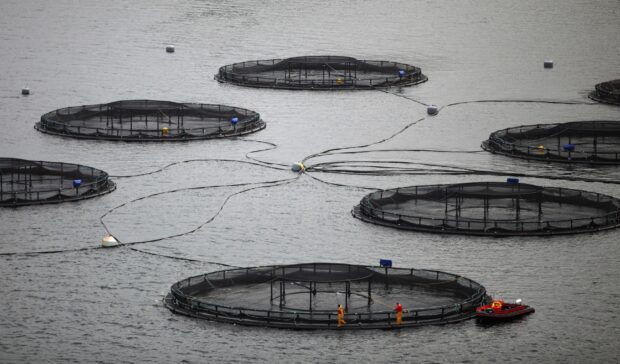Scottish Sea Farms’ (SSF) plans to expand two of its existing salmon farms in Orkney waters have been given the green light by Orkney Council’s planning committee.
The first of these farms is at Toyness, Orphir, Scapa Flow and the second is in waters near Bring Head, Hoy.
Both applications were objected to by the Orkney Trout Fishing Association, which has said sea lice numbers at the sites have been above the industry threshold over the last nine months, according to industry figures provided by the Scottish Government.
The Scapa Flow site will see the expansion of 10, 80-metre circumference salmon pens, to 12 cages, 120m in circumference.
The farm will also be moved 130m to the south-west of the current site. It will have a 420-tonne capacity feed barge, compared to a previous 200-tonne barge.
Aside from the objection from the OTFA, two nearby residents also objected.
Sea lice, noise, and visual impact
This was on the grounds of noise, visual impact, and the impact on birds, other wildlife, and the seabed.
Likewise, the Hoy site will be expanded from 10, 80m pens, to 12, 120m cages. This will include another 420-tonne semi-automated feed barge. The cages would also be moved 190m to the north east.
Both applications were recommended for approval by the council’s planning officers.
In a letter to the committee, the OTFA said sea lice “had come to be an issue at both sites”.
They said this was a concern for the health of wild sea trout
This “proves SSF cannot deal with the problem, despite their assertions to the contrary”, the OTFA claims.
The association said industry data showed, in 2021, approximately 1,500 tonnes of salmon died at farms in Scapa Flow due to disease.
There is “an urgent need to look at how the industry can dove-tail sustainability into the marine environment of Orkney”, the OTFA said.
Speaking on behalf of SSF was Richard Darbyshire, the company’s regional production manager.
£10m investment
He outlined the economic benefits the company has provided in the county, its support for the community, and salmon farming having a lower carbon footprint compared to other industries.
He also said the expansion of the farms is necessary due to increased costs caused by global inflation.
Doing so would safeguard jobs and help meet the increasing demand for the product, he said.
Councillors questioned Mr Darbyshire on sea lice numbers and treatment. He was also asked about the fish mortality rates
He replied that the average mortality rate is between around 5 and 7%.
SSF is confident sea lice is “a problem it can control”, Mr Darbyshire said.
He said the current levels of sea lice in Scapa Flow are “very low.”
He said figures show the average is 0.22 average sea lice females per fish.
Describing the measures the company is using to deal with the lice, he said they are using, cleaner fish, for example.
Measures being used to tackle sea lice
The company is moving away from using medicines, he said. Sea water under pressure can be used to knock lice off. Warmed-up water is also being used to dislodge lice from the fish.
The company is also looking at treatments which put fish in freshwater 10 to 12 hours at a time, which he said: “removes every stage of sea lice”.
He said the expansion of the farms is a £10million investment for SSF.
If they were “problematic farms”, he said, they wouldn’t be making such an investment.
Councillor Graham Bevan said that any improvements that meet the requirements of the fish farming industry should be investigated.
He also noted the concerns that many people express around the industry.
Mr Bevan said he hoped the council could be open to supporting any reasonable approach to dealing with such concerns.
After hearing about SSF’s measures, the committee chairman, Owen Tierney said he had been reassured.
He said he was glad to hear that SSF didn’t “have as serious a problem as is being intimated by the trout fishing association.”

Conversation